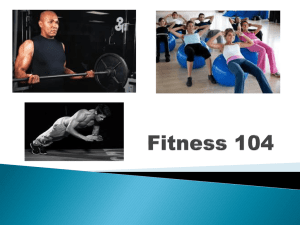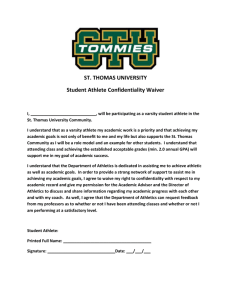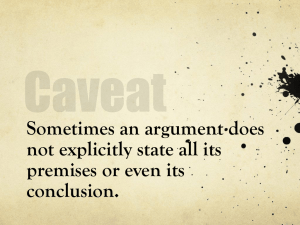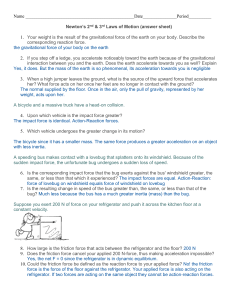The Jerk
advertisement
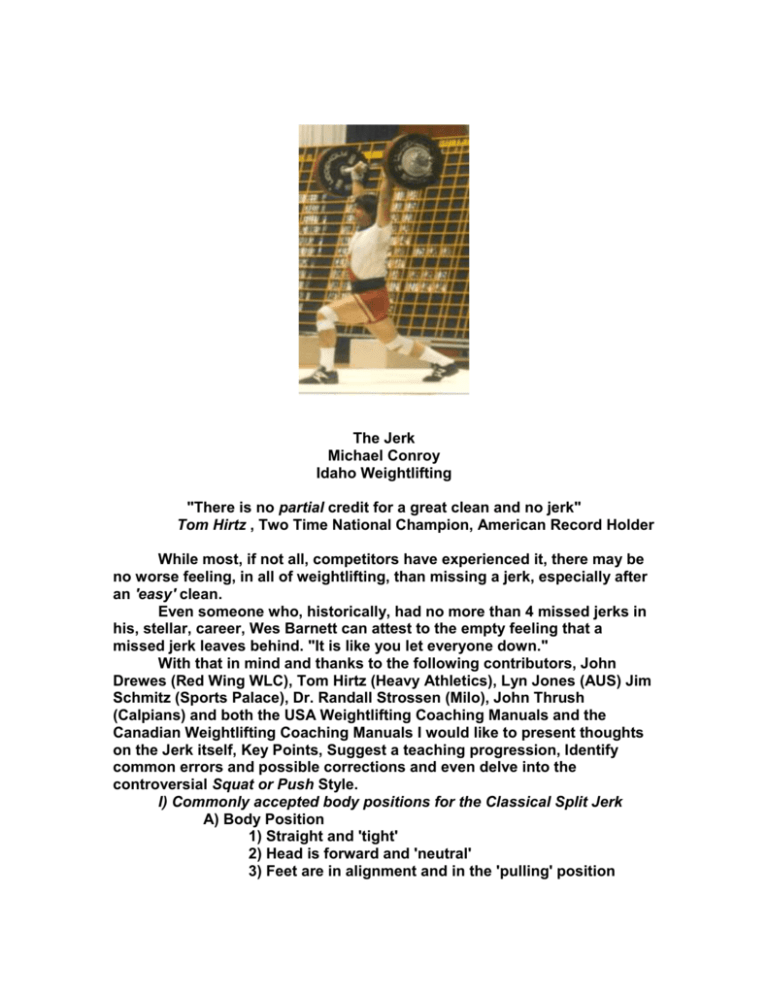
The Jerk Michael Conroy Idaho Weightlifting "There is no partial credit for a great clean and no jerk" Tom Hirtz , Two Time National Champion, American Record Holder While most, if not all, competitors have experienced it, there may be no worse feeling, in all of weightlifting, than missing a jerk, especially after an 'easy' clean. Even someone who, historically, had no more than 4 missed jerks in his, stellar, career, Wes Barnett can attest to the empty feeling that a missed jerk leaves behind. "It is like you let everyone down." With that in mind and thanks to the following contributors, John Drewes (Red Wing WLC), Tom Hirtz (Heavy Athletics), Lyn Jones (AUS) Jim Schmitz (Sports Palace), Dr. Randall Strossen (Milo), John Thrush (Calpians) and both the USA Weightlifting Coaching Manuals and the Canadian Weightlifting Coaching Manuals I would like to present thoughts on the Jerk itself, Key Points, Suggest a teaching progression, Identify common errors and possible corrections and even delve into the controversial Squat or Push Style. I) Commonly accepted body positions for the Classical Split Jerk A) Body Position 1) Straight and 'tight' 2) Head is forward and 'neutral' 3) Feet are in alignment and in the 'pulling' position B) Barbell Position 1) Bar 'rests' on the anterior deltoids 2) The grip is, actually, relaxed C) The "Dip" 1) Drop Hips, as if sitting into a chair 2) The Dip is short, shallow, straight and quick 3) Maintain contact during the dip a) Do not allow the bar to get 'separation' from the shoulders D) The "Drive" 1) As soon as the athlete 'dips' and feels that they are 'flat-footed' (This is often referred to as Jerking "off the heels") The athlete drives upwards right back where they came from. E) The Split 1) The feet move an equal distance fore and aft. 2) The front foot should move One and One half shoe lengths from the starting position 3) Both feet should land at the same time 4) The Knee of the front foot should be behind the tip of the shoe and be flat to the platform. (The shin should be perpendicular (90') to the knee joint) 5) The rear leg is slightly bent 6) The rear foot is on the 'ball' with the heel 'up 7) The original 'pulling position' lateral distance is maintained. This means that the feet drive straight forward and not 'wider' or more narrow in width then their starting position F) Recovery 1) Front foot comes 'back' a half step 2) Rear foot comes 'forward' a half step. 3) Front foot comes 'back' into alignment with rear foot. II) Key Points Once the lifter has recovered from the clean, they should step their feet back into line until they are approximately in their 'pulling' position. This position, sometimes referred to as the 'vertical jump' position has been found to be most efficient for exerting upward force through the body and into the barbell. The barbell should rest on the shoulders and upper chest. It is essential that the lifter GET SET for the jerk in the most methodical manner possible. (Those of us who have been in the sport long enough to have seen USAW International Coach Steve Gough shout the words "GET SOME AIR!!!" know the importance of 'setting a platform' and the horror of 'rushing' a jerk.) Arm position, prior to jerking is, as Lyn Jones would always comment "worthy of mention”. The barbell should NOT be gripped tightly and, in fact a slack grip should be adopted (NOTE: Back in 1998 I had the pleasure of working with Junior World Championship Bronze Medalist Sally Oakes at the NACACI Championships. In our pre-competition meeting I asked her if she had any 'trigger' words that she liked to hear and Sally replied. "When you see that I am 'set' just yell out "fingers". On her first jerk I did so and right before she dipped she wiggled her fingers, to relax her grip, and then jerked the weight. She placed second to Olympic Champion Soraya Jimenez of Mexico and by only 2.5kg!) IF the lifter grips the barbell tightly the arms and shoulders may tense up and the lifter will tend to push the barbell away from their shoulders which will cause a re-action of pushing themselves away from the barbell, ending up behind it and losing the jerk out in front. A lot of discussion has been about, exactly, where to place the elbows and without getting into all the possible variations I will defer to Lyn Jones who stated "When the grip is relaxed, the elbows will go, comfortably, to where they should anatomically. Now this will cause each lifter to look different but if the basic Bio-mechanics that govern The Jerk are adhered to it will not create any concern.” WHAT IS IMPORTANT is that the elbows do not change position when the dip occurs. This is true for both 'fingertip' Jerkers (Wes Barnett) or traditional Jerkers (Casey Burgener). The DIP is, without question, the most important phase of the jerk. When a jerk is lost it is usually lost here. This is when the lifter exerts maximum force on the barbell before moving into the receiving position. Keeping the body completely vertical the athlete bends the knees. (Former US National Coach Dragomir Cioroslan would say "Drop your hips as if you are sitting into a chair.” This makes you both flatfooted and 'sets the weight back and not forward.") The athlete should feel the weight on their heels. The dip is quick and shallow. If the athlete dips to deep the weight will shift forward and a forward lean will result in a total disaster. The speed of the dip is also of importance because if it is too fast the athlete will lose contact with the shoulders. Too slow and the athletes knees will get driven forward and the barbell will follow right along. As soon as the athlete dips they should 'drive out of it'. The result of this is similar to the process of blocking in both the high jump and the long jump. The quick turn around of momentum will cause that force to be exerted onto the barbell and assist in the lift being successful. (In jumping blocking helps turn horizontal momentum into vertical momentum.) Contrary to popular belief athletes do not drive the barbell up very far, nor should they try to. What they should strive to do is STEP THROUGH THE JERK. The lifter drives, with leg extension, up into the toes before splitting the legs both fore and aft. The athlete should not push with their arms against the bar (because in reality MOST athletes are jerking weights that are in excess of their body-weight) as this will result in them being pushed away from the barbell. To jerk well the athlete must drive with their legs and wedge themselves under the barbell. Once the athlete lands and is in proper position NOW they push against the barbell with their arms. This action is swift and dealt with authority and as such will accelerate the lifters descent under the barbell into the final receiving position with the hips and shoulders in alignment and the elbows locked out. When the feet land they should not stamp hard onto the platform. If this does occur the force is transferred back into the lead leg and causes it to straighten. This will, in the domino effect, cause the rear leg to be pushed out of its correct position and now the athlete is scrambling to try and save the lift. The recovery should be controlled and unhurried. IT IS important the athlete recovery front foot back first. When the athlete does this it pushes the barbell back into the shoulder girdle and onto a bone support position. if the athlete recovers back foot forward, first, the jerk can be lost forward after all the work has been done. To Quote Lyn Jones. " As can be seen jerking weights is an extremely complex skill. More and more in elite competition we are seeing vital, if not critical, jerks lost, there are many theories as to why. In my way of thinking the athletes are finding it very hard to hold weights overhead in the split with the shoulders, hips and arms in one line. Developing shoulder strength equal to the athlete’s hip and leg strength is a challenge that coaches and athletes must meet”. Lyn's quote leads into the next part of the article III) Teaching Progressions Here are the various types of Pressing and Jerking Movements A) IN FRONT 1. Press 2. Push Press 3. Push Jerk 4. Split Jerk B) IN BACK 1. Press 2. Push Press 3. Push Jerk 4. Split Jerk C) REMEDIAL 1. 2. 3. 4. Footwork "Murray" cross Jerk Recovery "Pause"Jerks. Definitions PRESS: All effort is done with the arms only PUSH PRESS: The athlete dips the knees at the initial Movement but drives the knees up and to an Extended position PUSH JERK: The athlete dips, drives the barbell up and then Receives the barbell on a bended or flexed knee. SPLIT JERK: The classical movement explained in the article The main reason for using movements where the barbell is placed behind the athletes head is that this position causes two, hopefully, positive effects. One. The athlete's elbows will be positioned such that the athlete will be straight up and down in their alignment and Two the athlete’s weight is set behind making it easier to drive the barbell upwards and not forwards. Athletes that really have problems 'pushing the jerk out front' can benefit from behind the neck movements. Athletes and their coaches should build into their programs an overhead movement each session and should progress through the entire menu of suggested exercises and each assists the next. Hopefully all athletes are using a form of Periodization and the Pressing Movements fit, nicely, into a Cycle One, Pushing Movements, into a Cycle Two and Split movements into a Cycle Three. The JERK is a skill exercise and as such reps should be kept to singles, doubles, and triples and Triples should be no more than 75%. It serves little purpose and is of great risk to try and hit 90% for 5 as the risk of injury far outweighs the reward of a personal best in an assistance exercise. (NOTE: Thanks to the father of one of my athletes Idaho Weightlifting is the proud owner of a set of Jerk Blocks and these things are the 9th wonder of the world.) (NOTE: In the 1990’s, I used to watch two-Time Olympian Tim McCrea, who had a personal best 195kg C&J, perform Jerks with 50kg when he was at the U.S. Olympic Training Center and I was working with the National Junior Squad. I mean jerk, after jerk, after jerk. WITH 50kg!!! Just getting the feel for it. I found that real impressive. Remember Jerking is a Skill and you can approach it the same way as you would hit a bucket of golf balls. Lots and Lots of repetition.) IV) Faults and Corrections 1) Barbell is lost forward in receiving position a) Possible Cause: Forward lean on dip b) Possible Remedy: Push Jerks with emphasis on keeping body upright in the receiving position. Focus on timing between knees being bent and arms Being locked. Split Jerks with lighter weights and technique Correction 2) Being pushed away from barbell in split position a) Cause: Athlete is 'pushed forward' at the dip position b) Remedy: Pause Jerks (See Glossary) 3) Incomplete dip and drive a) Cause: Weak body levers b) Remedy: Build in pressing movements into each training session 4) Head "Sticks" through on receiving phase of jerk a) Cause: Jerk is 'placed' out front. b) Remedy: Technique re-enforcement with light weights with emphasis on keeping the head 'still' 5) Barbell slides down chest on dip. a) Cause: Loss of Chest compression b) Remedy: Have athlete take a deep breath prior to dipping and inflate chest. Also Incline pressing can help develop better chest muscles. 6) Athlete recovers forward a) Cause: Athlete 'sticks' jerk out front b) Remedy: Jerk Recoveries (See Glossary) 7) Lifter gets up on toes during dip. a) Cause: Athlete dips to deep b) Remedy: Push jerks, leaving feet in pulling position for reception phase. Emphasis on weight being on heels before jerking. 8) Lead leg (and or trail leg) is not placed properly in split a) Cause: Incomplete dip and drive b) Remedy. The Murray Cross (See Glossary) 9) Pressing out a) Cause: Poor Timing b) Remedy: Push jerks, both front and back Rack Jerks; Singles with 80% 10) Poor shoulder position a) Cause: Poor Flexibility b) Remedy: Push Jerk behind the neck 11) Front foot is short. (Knee is in front of toe) a) Cause: Not stepping through the jerk b) Remedy. Pause jerks and Fukada Jerks. (See Glossary) 12) Rear foot is flat (Heel on ground and or turned to the side) Rear Knee ‘straight’ a) Cause: In complete extension, not stepping through. b) Remedy: Murray Cross exercise and Pause Jerk. This FINAL section is PURE JIM SCHMITZ and he gets all the accolades. While I have taught the squat jerk and understand it I do not like it as I feel that there is no place to recover if it is not performed exactly. With that in mind I did see, at the 1996 Olympics, Zhan (China) Dimas (Greece) and Kakhiashvilis (Greece) each set amazing Olympic and World records using this style. Impressive to say the least. The PUSH JERK (PJ) is performed with the barbell on your deltoids and clavicles and slightly wider than shoulder grip, elbows slightly up, your feet about hip to shoulder width, your body, hips and legs in line, standing at attention and your eyes looking straight ahead, not up or down or side to side. You now lower your body straight down two to four inches by bending the knees, then you forcibly extend your legs and at the same time push with your arms the barbell around your chin and nose and over your head.; but as the barbell clears your head you rebend the knees two to four inches and catch the barbell directly overhead and ears, with the arms extended and the elbows locked. Then you stand up. (NOTE: In my speaking with athletes that do PJ they tell me two different approaches to the depth of the receiving position. One statement is that the depth they descend to is determined by their pushing up on the barbell. The heavier the weight the deeper they catch it. The second statement is that the athlete receives the barbell in a deep, similar to a full snatch depth position, each and every time regardless of the weight on the barbell. As a result of these discussions when I teach the PJ I have 3 points of emphasis. ONE. The athlete MUST keep their torso “perfectly” vertical in the reception phase. TWO. The timing of the feet “hitting” the platform and the elbows locking out must be simultaneous. THREE. The feet must move into the exact same position as they are in the back squat so that the athlete can descend their hips between and below their knees and be in the most balanced and powerful position possible.) The PJ can be tricky for some people. Some have trouble getting the rebending of the knees as the barbell goes overhead and catching the barbell in a position that allows them to have the timing and balance correct. Those that wish ti try the PJ need to be persistent and remember the essence of the PJ is DIP, DRIVE, DIP, and CATCH. GLOSSARY OF TERMS. 1. Jerk Recovery. (A Jim Schmitz exercise) Using a “power rack” the athlete sets the barbell at a height Similar to the reception phase of the jerk. The athlete then Steps into the rack and pushes up on the barbell until they Are in the split position. They then practice the front foot Back, rear foot forward recovery. (Traditionally very heavy Weights, ie.120% are used in this exercise) 2. Pause Jerks. (A John Thrush Exercise) Using weights in the 80% range the athlete ‘sets’ just as They would for a typical jerk. The difference is that when they ‘dip’ they pause at the bottom, just long enough to get the feeling of being flat-footed or feel the weight ‘on the heels’ and then perform the jerk. 3. The Fukada Jerk. Once again using weights in the 80% range the athlete sets as They would for a normal jerk. The difference here is that they Place their lead foot HALF THE DISTANCE that it should travel And then dip and place the lead foot in the proper position. (The rear foot stays in its original position but should go up onto the ball.) 4. The Murray Cross A very simple, very traditional and very effective tool for Improving jerk technique. A “Cross” (+) is drawn onto the Platform and the coaches watches both the starting position And receiving position of the athletes jerk. Feed back is Immediate as to proper alignment and corrections become ‘easy’ to make.
